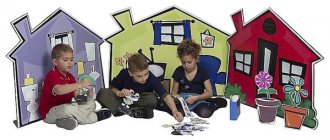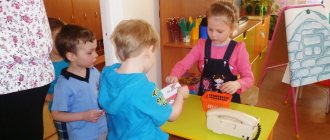It's a disaster when children get sick. Their fragile body is struggling, and we are trying our best to help the child: we examine him with the best specialists, get effective medicines, and try to ensure peace.
All this is correct in the complex course of the disease. However, there are still a number of points that escape our attention. Thus, the psychophysiological characteristics of the child’s body play a very important role. And this means that recovery largely depends on the psycho-emotional state of the child. If in adults more than 70% of diseases have a psychosomatic basis, i.e. are the body’s reaction to our emotional problems, then children often “respond” with illness to the anxiety and concern of their parents. And this is exactly the state we find ourselves in when children are sick. This negative emotional background interferes with recovery.
Another feature of a child’s body is the constant growth of organs. Consequently, those muscles to which a stronger blood flow is directed, i.e., to organs that are in motion, develop more intensively. In addition, it is known that the muscular system in early life is closely related to the main regulatory mechanisms. Limited movement negatively affects not only the diseased organ, but also the nervous, endocrine and neurotransmitter systems as a whole. Restriction of movements (the child is sick or has just recovered and needs rest) affects posture, weakens the functions of breathing and blood circulation. Passivity in movement leads to a decrease in the flow of irritations perceived by the nerve endings of the skin, muscles, joints, in the visual and auditory analyzers, going to the cerebral cortex. As a result, disorders of the central nervous system and internal organs may develop: emotional tone decreases, the neuromuscular system is weakened, and the cardiovascular and respiratory systems work weaker. This means that the body as a whole is weakened, which leads to more frequent diseases.
These observations about the role of movement in human development and health are reflected in an entire field of medicine - therapeutic and preventive physical education. However, the child’s psyche, especially at an early age, is structured in such a way that it is almost impossible to force the child to purposefully perform any, even the most useful, exercises. The child should be interested in studying. That is why we present adapted, game-based exercises for health improvement and disease prevention. Their effect is not only in the treatment of children, such games-exercises contribute to comprehensive, harmonious physical and mental development, the formation of necessary skills, coordination of movements, dexterity and accuracy.
During the game, unexpected, funny situations often arise. This causes sincere joy in both children and parents. A relaxed, cheerful atmosphere does not allow the child to “go away” into illness, allows parents to show more attention to him and increases joint communication with children in an atmosphere of love and care. This is a very powerful therapeutic factor.
It should be noted that the healing effect of games is possible only with frequent and long-term exercise (3 - 4 months, 2 - 3 times a day).
Games for diseases of the cardiovascular system
“Finger on finger”
Goal. Balancing nervous processes, strengthening inhibitory reactions, performing actions on command, coordinating hand movements.
Progress of the game. The child is sitting in front of you. He repeats your movements to your song:
Finger on finger, knock and knock, (Repeat 2 times)
Clap, clap, clap, clap! (Clap their hands)
Stomp your feet, stomp! (Repeat 2 times)
Hid, hide (Cover your face with your hands)
Finger on finger, tap and tap. (Repeat 2 times).
Health games for primary and secondary school students.
Health games for elementary school students
and middle management.
Explanatory note.
These games can be used in lessons, during classes in an extended day group, during summer holidays in a health camp.
They help maintain the children’s motor mode and good posture.
This can be done both in the gym and outdoors. Each game can be diversified and new elements can be added.
1. “Tick-tock”
In a cross-legged position, the child sits with a straight back, hands on his knees. On a signal, shakes his head back and forth, right and left, saying “tick-tock”
" The teacher controls the child's posture.
2. "Swallow"
The student stands on one leg, the other is laid back, arms to the sides, torso tilted forward, head raised. The teacher holds the child by both hands (hereinafter one) and controls whether the spine is correctly straightened and the leg is raised. The pose is first held for no more than 1 second, and then the supporting leg changes.
3. "Ball Rolling"
Children roll balls or balls towards one another or towards the teacher. The rolling path gradually increases.
4. "Pass the ball"
The child sits on the floor, resting his hands behind him. The ball is placed at the feet on the right. Grab it with your feet, lift it and move it to the left.
5. “Jump into a circle”
Three circles are drawn near the stump (bench): one very close, the other further away, the third even further away. Children take turns jumping from a stump into a circle. The winner is the one who aims more accurately at each of the circles and does not fall. You need to jump off softly, springing on your toes.
6. "Balloons"
Children throw inflated balloons over a rope. They play in pairs.
7. "Between the Pins"
Set up the pins. The child walks around the pins placed in a row with a snake. The winner is the one who doesn't knock down any pins. You can walk between the pins with your eyes closed. You can crawl on your belly between
pins without hitting them. The same on all fours. You can play in teams.
8. “Whose jump is more beautiful?”
Competitions can take place between two children or several pairs. One child can also play, testing himself on the quality of the jump. You can jump standing in place, with both feet, on the move, while running, on your left, on your right foot, jump together, with your face and back of your head facing each other. The teacher doses the load according to the condition of the children. Noting the quality of the movement, the teacher says: “Whose jump is more beautiful?” Who could jump more beautifully?” Controlling correct posture.
9. "Obedient Ball"
Lying stretched out on your back, hold the ball between your legs. Turn onto your stomach without dropping the ball. Repeat 4 – 6 times.
What an obedient ball!
I tucked it between my legs.
Turn around and look back!
Ball, don't roll to the floor
!
10. “Who is more resilient?”
At a distance of 50 cm from each other, draw two circles with a diameter of approximately
25 cm. Two players stand on their left foot in their circle and try to move their opponent with their right foot. He loses. Who could not resist and touched the floor with his right foot.
11. "Smart Guys"
Children stand or sit. This game can be played by two to three students competing in agility (who can crawl under the rope or quickly climb over it without hitting it.) The game can be played in teams.
12. “Dancing Cossack”
The child, in a squat, throws one leg forward and places it on the heel. Then he changes the position of his legs. Later, with the help of an adult or leaning on a chair, he smoothly changes the position of his legs by jumping.
13. "Giant"
Walk, rising on your toes as high as possible. ( 45 minutes)
14. "Dwarf"
Walk, rising on your toes, bend your knees. (5 – 7 minutes)
15. "Horse"
Move in a circle, imitating the horse's pace at different paces: walk, trot, gallop (4 - 5 minutes).
16. "Migration of Birds"
Children run after each other and, waving their hands, imitate flying birds. At the signal from the teacher or presenter “wind, storm,” they climb the gymnastics wall. At the signal “good weather”, children run around the hall, and when the signal “wind, storm” is repeated, they again look for a place on the gymnastics wall. The one who took a place on the gymnastic wall at the first signal must find a new place at the second signal. The game is repeated several times. Finally, all children should adopt correct posture. And the teacher controls the quality of the exercise.
17. “Posture control”
At the teacher’s suggestion, the child approaches the wall without a plinth, takes the correct posture: arms down, back of the head, shoulder blades, buttocks, heels firmly touching the wall, head straight, neck vertical, gaze directed forward, lips closed, shoulders slightly lowered, shoulder blades at the same level flattened, the front surface of the chest is turned out, the stomach is slightly tucked, the buttocks are tense, the knees are straightened. Sliding along the wall with the backs of the hands, they raise their arms slightly, their fingers spread apart, like a Christmas tree’s needles, tense. In the “doll” pose, move 3–4 steps away from the wall
(the pose is tense), then lower your arm freely, but keep your entire torso and head straight, walk 1-2 steps around the hall, maintaining correct posture. Children who managed to do the entire “posture control” task better are noted.
18. “Stretched out - curled up”
While lying on his back, the child raises his hands behind his head and stretches out as much as possible. Then, raising the upper half of the body to the knees, leans forward, i.e. groups itself, clasping its legs under the knees. Repeat 2 – 6 times. Between each repetition, rest, lie down like a rag doll, relax.
19. “My cheerful ringing ball...”
Children sit or stand at a distance of 1 meter from each other. They are given small balls. Together with the teacher or presenter, the children hit the ball on the floor and catch it with one hand to the poem:
My cheerful ringing ball,
Where did you go at a gallop?
Red, yellow, blue.
Can't keep up with you.
Then they pass it to each other one by one. Whoever dropped the ball is out of the game. The rest of the children start the game again. Play 2 – 3 times. The teacher monitors correct posture.
20. "Carousel"
Children stand in a circle with hoops. Everyone holds on to their hoop and their friend’s hoop. It turns out to be a big vicious circle. At the signal “let’s go!”
everyone starts moving at a pace; at the signal “run!” everyone runs at the signal
"jumping!"
begin to jump, putting one foot to the other (i.e., side gallop).
To the words “Hush, hush, don’t rush.
Stop the carousel!” start walking calmly and stop.
When the teacher says “ let’s rest!”
everyone puts the hoops on the floor and disperses in different directions, away from the lying hoops. Hearing the signal
“The carousel is starting!
", everyone runs to the hoops, quickly takes them and the game repeats.
21. "Swing"
Children lie or sit on the floor, legs extended. At a signal, the teacher swings their feet to the sides (right and left). They bend and unbend. Repeat 2 – 6 times.
22. "Ball School"
1) Throw the ball up, clap your hands behind your back and catch the ball.
2) Throw the ball up, turn around and catch the ball.
3) Throw the ball up. Sit cross-legged. And catch the ball.
4) Squat down, throw the ball up, jump to your feet and catch the ball.
5) Throw the ball high up, bend over, touch the tips of your fingers to your toes, straighten up and catch the ball.
6) Hit the ball on the ground or floor so that it bounces high, then bend down. Touch the tips of your fingers to your toes and, straightening up, catch the ball.
7) Hit the ball hard in front of you on the ground or floor, turn around and catch the ball.
 Raise your right leg, extending it slightly forward, and throw the ball with your left hand on the ground or floor so that it passes under your right foot. Then catch the bounced ball from the right without lowering your feet. Do the same exercise by lifting your left leg and throwing the ball with your right hand.
Raise your right leg, extending it slightly forward, and throw the ball with your left hand on the ground or floor so that it passes under your right foot. Then catch the bounced ball from the right without lowering your feet. Do the same exercise by lifting your left leg and throwing the ball with your right hand.
9) Draw a circle on the ground, run around it 3 times, hitting the ball with the palm of one hand (either right or left).
23. “Bridge over the river”
Sit on the floor, stretch your legs, lean on your palms behind your body. Bend forward and upward, raise your pelvis, resting on your heels and hands (make a bridge).
Return to standing position, get on all fours, run 5 meters. Repeat
4 – 6 times.
Bridge, bridge across the river -
It was I who took the place.
Became a bridge over the river,
Soon I'll run down the river
The game can be a team game. Competitions can be held between teams for quality and speed of execution.
24. "Fish"
The players are standing. A pond is outlined - an area beyond which you cannot go. The children smoothly spread their arms: “The fish are swimming.” Two “fishermen” stretch the rope - the “net” and try to twist and catch the “fish”. The “fishes” dodge. Those touched by the jump rope leave the game. When all the “fish” are caught, the game is repeated with new “fish”, which are assigned to the most dexterous children.
Oz preschool games for primary and secondary school students
compiled by physical education teacher, life safety teacher and life safety organizer V.V. Shavrin based on materials from publications from different years. Personal materials were also used.
Game as a form of correctional work with primary schoolchildren
Game as a form of correctional work with primary schoolchildren
The era of childhood - that’s what D.B. called it. Elkonin two successive and closely related periods in child development - preschool and primary school. At the junction of these periods, children not only develop new psychological formations and the social situation of development changes, but also the leading types of activity change: play activity gives way to educational activity. But at school, games still occupy a significant place in a child’s life, performing,
As a form in which the content of a new activity (learning) can be most successfully absorbed;
As an emotional support for the individual, facilitating adaptation to school conditions and facilitating psychological comfort;
As an element of creative self-expression, manifestation of independence and activity of a student among his peers.
Certain and significant changes in the nature of the game of younger schoolchildren: the game begins to be subordinated to educational activities, etc.
At the same time, the game retains its main features, which fundamentally distinguish it from other types of activities: voluntary participation of participants, initiative, proceeding within a certain and time frame, unpredictability of development and results, creativity, illusoryness.
The desire to learn and the desire to play coexist peacefully in children throughout their early childhood. In games, elementary school students, just like preschoolers, realize not only a variety of impressions and knowledge, but also spiritual needs, which opens up wide opportunities for adults to use game resources in order to optimize the process of their education.
The recent processes of formation of a system of social-psychological-pedagogical assistance and support for childhood allow us to substantively discuss and study another aspect - the place of play in solving problems of prevention, diagnosis, and correction of undesirable variants of child development.
Play and correction of deficiencies in the social and personal development of younger schoolchildren.
The history of the implementation of diagnostic and correctional functions of children's play shows that S. Freud was at the origins of the development of this issue. He considered play as a method of cognition and a method for correcting the development of a child’s personality. “Symbolic activity. In which the child, being freed from pressure and prohibitions from the social environment, expresses unconscious impulses and drives in a special form with the help of toys, playful actions with them and roles.”
In the 30s of the twentieth century. A new direction in psychotherapy has emerged - play therapy. It was intended to work with children who have experienced any traumatic events. Another direction was play therapy for relationships, which proclaimed the need to treat the child as an individual. Possessing inner strength and the ability to constructively change one's behavior.
At the present stage, play therapy is presented in two forms - directed (directive) and non-directive (non-directive) play therapy. The differences between the two lie in the functions and role of the play therapist. If, as part of directed therapy, he discusses with the child his feelings, emotions, actions with toys, i.e. plays an active role, then in the second option the child is given complete independence; in the game he realizes himself, his shortcomings and advantages, overcomes his difficulties and overcomes conflicts.
It is customary to distinguish between individual and group forms of organizing gaming correctional influence. The main indications for group play therapy are difficulties in communication, voluntary regulation of behavior and activity, emotional problems, and fears. In cases where children, in addition to the problems mentioned above, have an undeveloped need for communication, a current stressful state, etc., group therapy should be preceded by its individual form.
The use of play therapy in working with primary schoolchildren is the work of a specialist who has undergone appropriate training (educational psychologist, practical psychologist, psychotherapist, special education teacher). At the same time, the teacher is recommended to use in his teaching activities those elements of types of therapy that are simple in technique, but effective in terms of developing adequate behavioral attitudes and self-esteem of students, improving communication skills, relieving emotional stress, and developing creativity.
Play and correction of difficulties in the cognitive activity of younger schoolchildren
For a primary school teacher, a game can become one of the tools for developing school-significant psychological and psychophysiological functions of students, activating their cognitive abilities, and cultivating a sustainable interest in and need for intellectual activity.
P.F. Kapterev pays special attention to the importance of games in educating schoolchildren's concentration, observation, intelligence, resourcefulness, creativity, improving organs, thinking and logical operations (analysis, synthesis, induction, etc.).
Modern scientists emphasize that the game helps the development of students’ cognitive abilities, and can also serve as an effective means of overcoming difficulties in this development, a “generator” of the process of psychological and pedagogical correction. Provided the correct methodological instrumentation is used, the game encourages students to “force their thoughts” and easily and freely stimulates them to understand the world. S.A. Shmakov believes that the very name of the games used for this purpose - intellectual, mental, educational, didactic - sounds encouraging and emphasizes their appeal primarily to the intellect, the development of all properties of the mind and stimulation of cognitive activity of children. Such games can be built on educational and non-educational material and included in the structure of any lesson on any subject. Most didactic games are based on competitiveness (who knows more? Who can name it more accurately? Who is the most observant?) and can be carried out in the form of an individual or team championship among students.
So-called leisure intellectual games also have significant potential for cultivating intellectual activity, curiosity, and broad cognitive motives. These include the games “What? Where? When?”, “Brain Ring”, “Field of Miracles”, etc.; “Project Defense”, “Tournament of Experts”; travel games “To the Land of Fairy Tales”, etc. The correctional, developmental and didactic effect of these games is to create conditions that give children the opportunity to enjoy expanding their horizons and the ability to use their knowledge; they model life situations of struggle and competition, identify the personal qualities of the participants and unite them.
Educational computer games are also an effective means of improving functions and processes that are significant for educational activities. They can be successfully used in correctional and developmental practice; it is only important to remember the need for strict adherence to sanitary and hygienic standards.
Despite the “pleasantness and ease”, “various usefulness” that intellectual and cognitive games bring to the correctional and developmental process, teachers should be warned against being overly enthusiastic about them. Mental stress during these games is often accompanied by prolonged static tension and low mobility of students, therefore games must be dosed and rationally integrated into the life activity of younger schoolchildren, alternating with periods of predominantly physical activity and high physical activity of children.
Play and recreational work with primary schoolchildren
Children's play has another important function - therapeutic and recreational. The use of outdoor, sports or special recreational games should become an integral component of the program of correctional and developmental work with primary schoolchildren and contribute to their physical development, health promotion, and improvement of neuropsychic regulation.
The physical and mental components in these games are closely related. Thus, in outdoor and sports games, children not only realize their need for movement, expend accumulated energy and improve basic motor skills, but also learn, on the one hand, initiative, independence, perseverance, and on the other, the ability to control oneself and read with partners , coordinate your actions with the actions of other players. Such games are a good means of training depending on changing circumstances, but in accordance with a certain plan for switching attention and developing such qualities as flexibility.
Thus, an analysis of the correctional and developmental resources of children's games leads to the conclusion about their great significance and effectiveness in solving the problems of prevention, diagnosis and correction of problems in the social, personal, cognitive and physical development of primary schoolchildren. A correctly selected, appropriately and skillfully conducted game should be considered as important an element of educational work in primary school as a lesson. Consequently, play should be present in the daily routine to the extent that it is necessary to create a “harmonious combination of mental, physical and emotional stress, correction and stimulation of all aspects of child development.
Project. in the senior group “Seven Flowers” Topic: “Games that heal”
Transcript
1 Municipal budgetary preschool educational institution kindergarten 14 of the municipal formation of the city of Novorossiysk Project in the senior group “Seven Flowers” Topic: “Games that heal” Prepared by teacher: Samokhvalova O.I.
2 Goal: Strengthening the health of children through the organization of special outdoor games and games with elements of sports. Objectives: 1. Formation of ideas about the capabilities of your body, about the need to maintain health. 2. Promoting the formation of a harmonious physique, correct posture, foot, and nasal breathing. 3. Maintaining a positive psycho-emotional state. 4. Development of basic physical qualities and motor abilities. 5. Satisfying the need for movement. 6. Formation of the ability to follow the rules of the game and obey their requirements. 7. Encouraging motor creativity. Hypothesis: Properly selected and organized play contributes to the health of the body and contributes to the process of proper physical development of the child. Project participants: Senior children, parents, teachers. Implementation period: From November 7, 2021 to November 18, 2021. Forms and methods of project implementation: Methods: Forms: games for maintaining posture morning exercises and strengthening the foot physical education classes sports games physical leisure games for development and hardening breathing restoration Health days finger games advisory work games on the street independent motor round dance games activity play massage dynamic pauses and gymnastics for the eyes, physical training sessions. Expected results: 1. Increased emotional, psychological, physical well-being. 2. Preserving and strengthening the health of children through fostering a conscious attitude towards their health. 3. Observation of positive dynamics of health improvement (transition of children from the group of frequently ill people to the group of occasionally ill people). 4. Mastering self-healing skills. 5. Organization of work to improve the health of the child’s body with the help of health-related games.
3 Project resources: 1. Music hall. 2. Physical education corner in the group. 3. Sports area on the territory of the preschool educational institution. 4. Sports equipment: traditional and homemade. 5. Card index of games. 6. Selection of methodological literature. Stages of project implementation Preparatory 1. Determination of the goals and objectives of the project. 2. Drawing up an action plan. 3. Selection of methodological literature. 4. Introducing parents to the project. Main 1. Studying the necessary literature. 2. Conducting gaming and leisure activities. 3. Involving parents in direct participation in ongoing events. 4. Writing notes on events. 5. Enrichment of the subject development environment in the gym and in groups. 6. Creation of a card index of health-related games. 7. Selection of rhymes and riddles on the topic. 8. Assist preschool teachers in selecting and conducting games. Activities for children: 1. Participation in all activities of the plan. 2. Memorizing poetry. Event for parents: 1. Direct participation in classes and holidays. 2. Manufacturing of the necessary equipment. Final 1. Summing up. 2. Analysis of the implementation of the action plan. 3. Analysis of the success of working with children and parents. Project implementation plan: 1. Selection of games. 2. Introduction of health-improving games into the motor mode. 3. Inclusion of game exercises for the eyes in organized educational activities (card index). 4. Consultation with teachers “Methodology for conducting outdoor games” date November 10, 2021 5. Physical education “In the Land of Fun Balls” date 11
November 4, 2021 6. Inclusion of games in the motor mode to prevent flat feet and maintain correct posture (card index). 7. Learning games to develop correct posture: “Draw a picture”, “Find the treasure”, “Wash”, etc. with children. 8. Presentation at a teachers’ meeting for educators on the topic: “Outdoor games that are therapeutic for children 5-7 years old” (presentation). 9. Consultation for parents “Games that heal.” 10. Physical education “Sports Ball” date: November 17, 2021 11. Summing up. Analysis of the implementation of the action plan November 18, 2016 Conclusion. The “Games that Heal” project achieved its goals and objectives. The introduction of health-improving games into work practice allowed us to achieve positive results in preserving and strengthening children’s health, developing children’s value attitudes towards health and a healthy lifestyle, preventing and correcting musculoskeletal disorders, strengthening the respiratory system, developing fine motor skills, and preventing vision . As a result of the project, a system of games, activities, recommendations to parents on what games to play with children was developed (descriptions of the games were displayed in the parents' corner), scenarios for physical education leisure and holidays were compiled, a card index was created: finger gymnastics, breathing exercises, massage and self-massage, outdoor games , counting rhymes, riddles, a card index of corrective games aimed at preventing flat feet and developing correct posture. A lot of work has been done to create a subject-development environment in the group room, aimed at the physical development of all children and children with functional disabilities. We can say that the work carried out gave good results and helped to arouse greater interest among parents in preserving and strengthening the health of their children. Efficiency criteria: 1. Creation of a health-preserving environment that promotes not only the preservation, but also the development of physical, mental, and emotional health. 2. Development of optimal motor mode. 3. Providing conditions for the practical implementation of an individual approach to protecting children’s health. 4. Improving the qualifications of preschool employees, increasing the level of pedagogical and practical knowledge and skills for application to children.
5 5. Stimulating increased attention among parents to children's health issues. The project has practical significance. The problem of children's health is currently very relevant. To be healthy, you need to master the art of maintaining and strengthening it. This art should be given as much attention as possible in a preschool institution. It should be remembered that only in preschool age is the most favorable time for developing the right habits, which, in combination with teaching preschoolers health-saving technologies for maintaining and promoting health, will lead to positive results. Therefore, work to improve children's health will continue. Literature: 1. O.V. Kozyreva “Therapeutic physical education for preschool children” - M.: 2005. 2. E.N. Varenik “Physical and recreational activities with children 5-7 years old” - M.: 2008. 3. T.G. Anisimova, S.A. Ulyanova “Formation of correct posture and correction of flat feet in preschool children” - Volgograd: 2009. 4. E.I. Podolskaya “Therapeutic gymnastics complexes for children 5-7 years old” - Volgograd: 2010. 5. E.A. Babenko “Games that heal” for children aged 3-7 years M.: 2010. 6. Magazine “Preschooler’s Health” 6/2009.






